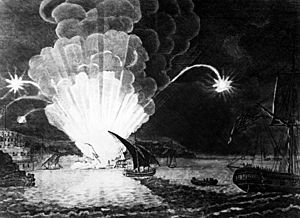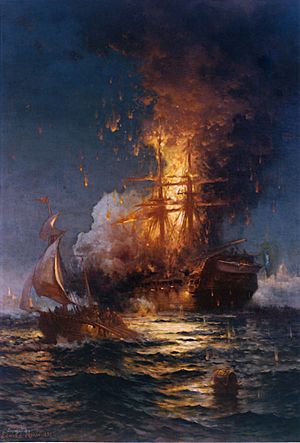USS Intrepid (1798) facts for kids
The first USS Intrepid was a small ship called a ketch. The United States Navy took control of her during the First Barbary War.
Intrepid was built in France in 1798. She was originally made for Napoleon's trip to Egypt. Later, the ship was sold to Tripoli. There, she was known as Mastico. This ship was a bomb ketch. She helped Tripoli capture the American ship Philadelphia. This happened on October 31, 1803. The Philadelphia had gotten stuck on a reef near Tripoli.
Contents
How the Intrepid Was Captured
The American ship USS Enterprise captured Mastico on December 23, 1803. The Enterprise was a schooner led by Lieutenant Stephen Decatur. Mastico was sailing from Tripoli to Constantinople under Turkish flags. She did not have the right travel papers.
It took time to find someone to translate the ship's documents. An English ship captain also shared what he saw in Tripoli. He confirmed Mastico's role in capturing the Philadelphia. This convinced Commodore Edward Preble, the American squadron commander. He decided Mastico was a legal prize. The U.S. Navy took her and renamed her Intrepid.
Destroying the USS Philadelphia
The captured Philadelphia was in Tripoli Harbor. She was a big threat to the Americans. Commodore Preble decided he had to destroy her. This would stop the enemy from using her against his ships. He needed to surprise the Tripolitans.
He chose Intrepid for this dangerous job. She looked like a North African ship, so she could sneak in. Lieutenant Stephen Decatur became her captain on January 31, 1804. He was told to get her ready for a month-long trip to Tripoli. The Syren would go with her.
Preble's orders were clear. Decatur was to enter the harbor at night. He would board and burn the Philadelphia. Then, he would escape in Intrepid. If possible, he could also use Intrepid as a fire ship to attack other enemy ships. If he used her as a fire ship, he would escape in small boats to the Syren. The Syren would wait just outside the harbor.
Intrepid and Syren sailed on February 2. They reached Tripoli five days later. Bad weather delayed their plan until February 16. That evening, Syren waited outside the harbor. Her boats were ready to rescue anyone. At 7:00 PM, Intrepid entered the harbor. Two and a half hours later, she was next to Philadelphia.
When asked who they were, they pretended to be traders. They said they had lost their anchor in a storm. They asked to tie up to the frigate until morning. But guards noticed Intrepid still had her anchors. They raised the alarm.
Decatur led 60 of his men onto the Philadelphia's deck. He left a small group with Surgeon Lewis Heermann on Intrepid. The Americans quickly took control of the frigate without firing a shot. They set her on fire. Decatur was the last person to leave the burning ship. He stayed until flames burst from the decks and ports.
When he finally left, the ship's ropes and top parts were on fire. Shore cannons began firing at Intrepid as she escaped. But the burning Philadelphia's own guns fired back as the heat set them off.
When Lord Nelson heard about Intrepid's brave act, he praised it. He called it "the most bold and daring act of the age."
Intrepid returned to Syracuse on February 19. The next day, her crew went back to their original ships. The ketch stayed in Syracuse with only a midshipman and a few sailors. She became a hospital ship on June 1. She continued this duty through July.
On August 12, she left Syracuse for Malta. There, she picked up fresh supplies for the squadron. She rejoined the American ships off Tripoli on August 22.
The Intrepid as a "Floating Volcano"
A week later, Intrepid was prepared as a "floating volcano." The plan was to send her into the harbor. She would explode among the enemy ships, close to Tripoli's walls. The ship was filled with 100 barrels of gunpowder. She also had 150 shells. The fuses were set to burn for 15 minutes.
Carpenters from all the ships helped get her ready. She was prepared by September 1. But bad weather delayed the mission until September 4. That day, Lieutenant Richard Somers took command of the fire ship. Midshipman Henry Wadsworth and ten sailors volunteered for the mission. Midshipman Joseph Israel arrived with last-minute orders. He insisted on joining the expedition.
Two of the fastest rowing boats were chosen to help. They would bring the volunteers back after the mission. At 8:00 PM on September 4, Intrepid started moving. The ships Argus, Vixen, and Nautilus went with her. They escorted her near the harbor's entrance. They stayed there to watch and pick up the returning rowing boats.
As Intrepid got closer to the enemy ships, she was spotted. Shore cannons fired at her. At 8:30 PM, before Intrepid reached her final spot, she exploded. The explosion lit up the whole area. The ship's parts, ropes, and exploding shells flew everywhere. Everyone on board was killed.
The crews of the waiting American ships felt the shock of the huge blast. But they could not tell what had happened. They waited all night, hoping the rowing boats would return. By morning, their hopes turned to sadness. The daylight showed them the disaster.
Commodore Preble later thought that enemy ships tried to board Intrepid. He believed Somers chose to destroy the ship, himself, and his crew. This would prevent capture and enslavement. But no one truly knew the exact events that caused the explosion.
What Happened After
The bodies of the 13 sailors washed ashore the next day. Angry local people dragged them through the streets. The bodies were buried in an unmarked grave outside Tripoli.
In 1949, the Libyan government found the remains. They moved them to the current cemetery. Rear Admiral Richard H. Cruzen represented the U.S. Navy. He was at the ceremony to unveil a monument for the fallen sailors on April 2, 1949. Since then, the Libyan government has cared for the grave site.
On December 17, 2011, US defense chief Leon Panetta visited the cemetery. He placed a wreath at the grave site. The U.S. has no plans to move the remains back to the U.S.
See also
Images for kids





